Maintaining a thriving aquarium goes beyond simple cleaning; it involves cultivating the appropriate beneficial bacteria in aquarium.
These minute organisms promotes the well-being of fish and other aquatic life. But what exactly do these beneficial bacteria for fish tank do, and how can you ensure their presence in your tank?
Let’s delve deeper into understanding the significance of these helpful and good bacteria for fish tank.
What are Aquarium Beneficial Bacteria?
In an aquarium, there exists a crucial presence of beneficial bacteria. These beneficial bacteria in aquarium play a vital role by consuming the waste produced by fish and plants.
This waste has potential harm, but thanks to the bacteria’s ability to transform it into something safer, they ensure the overall safety and cleanliness of the water.
These helpful good bacteria for fish tank, reside in various parts within the tank such as filters, gravel, rocks, and decorations. The positive impact brought about by these resilient organisms can be compared to that of natural cleaners.
Moreover, they maintain clean and safe water conditions for fish inhabitants by efficiently breaking down any pollutants resulting from their activities or plant debris.
Thus, these remarkable beneficial in aquarium filter deserve recognition for being aquarium superheroes who safeguard not only optimal health but also provide an ideal living environment for fishes.
Disclosure: This article contains affiliate links. When you follow a link to purchase the products, I sometime earn a commission, at no additional cost to you. Read my full disclosure here
Types of Aquarium Beneficial Bacteria
Contrary to popular belief, there exists a wide range of types of beneficial bacteria in aquarium that contribute to the breakdown of nitrogen compounds in aquariums.
However, for simplification, we can classify types of beneficial bacteria in aquarium, into two distinct groups:
Oxygen-Dependent Bacteria
There are several types of beneficial bacteria in aquarium that contribute to the nitrogen cycle.
AOB: (Ammonia Oxidizing Bacteria) such as Nitrosomonas spp.
NOB: (Nitrogen Oxidizing Bacteria) such as Nitrobacter spp
Both of them play important roles in converting ammonia into nitrites and then into nitrates. These types of beneficial bacteria in aquarium rely on oxygen to carry out these transformations, while also utilizing carbon dioxide for their own growth and development by synthesizing carbohydrates and proteins.
Oxygen-Independent Microorganisms
Now, let’s discuss microorganisms that thrive without the presence of oxygen, commonly referred to as anaerobic bacteria. These particular types of beneficial bacteria in aquarium, also play a significant role in the nitrogen cycle and can aid in reducing the need for aquarium maintenance.
An interesting aspect is that certain types, such as Heterotrophic bacteria, are capable of producing their own nourishment using organic substances. Interestingly enough, these anaerobic microorganisms have the ability to utilize nitrates instead of oxygen during their metabolic processes.
Consequently, they are able to convert nitrates into nitrogen gas even when there is an absence of oxygen.
Note: All types of beneficial bacteria in aquarium primarily derive energy from inorganic salts and typically cannot utilize organic materials. Moreover, these microorganisms rely on oxygen for growth and converting ammonia or nitrites into safer compounds.
The Purpose of Beneficial Bacteria
Beneficial Bacteria in Aquarium Filter
Aquarium filtration relies heavily on the presence of beneficial bacteria in aquarium filter to ensure proper water quality.
Two types of beneficial bacteria in aquarium, namely Nitrosomonas and Nitrobacter species, play a vital role in the nitrogen cycle. This process is essential for breaking down different forms of waste within the tank such as fish waste, leftover food, and decomposing matter.
The Nitrogen Cycle: Waste Transformation
The nitrogen cycle is a vital process within the ecosystem of your aquarium.
As waste materials break down in the tank, they release toxic ammonia, which can be harmful to fish. However, beneficial bacteria for fish tank play an integral role by converting this harmful ammonia into nitrites (specifically Nitrosomonas).
Although nitrites are still toxic, their toxicity is reduced compared to that of ammonia. Subsequently, another group of bacteria comes into action and converts nitrites into nitrates (particulary Nitrobacter), which pose less harm to fish health.
This cycle plays a crucial role in preventing dangerous spikes in ammonia levels and is particularly important for new aquariums.
Initiate the Cycling Process
It is frequently advantageous to introduce live nitrifying beneficial bacteria for fish tank to start and speed up the cycling process. These products can be especially useful when setting up the aquarium for the first time, following water changes, or when introducing new fish to the tank.
Managing the growth of algae and nitrates
Although nitrates are less toxic than ammonia or nitrites, they can still harm fish and encourage the growth of undesirable algae in high concentrations.
The denitrifying beneficial bacteria in aquarium filter are crucial in solving this problem. They turn nitrates into a safe gas called nitrogen. Low oxygen environments are ideal for these bacteria’s growth, and they need an organic carbon source.
Keep Aquarium Clean
The presence of beneficial bacteria in aquarium filter is crucial for maintaining the cleanliness of an aquarium.
These bacteria play a vital role in breaking down organic substances, preventing water cloudiness and debris accumulation on the tank floor. Heterotrophic bacteria, which obtain energy from organic carbon, are particularly important for ensuring clear and high-quality water conditions.
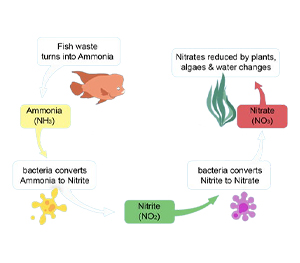
Where Do Beneficial Bacteria Live In Fish Tank?
Beneficial bacteria, also known as nitrifiers, can be found in various areas within your fish tank.
Contrary to common belief, they are not primarily floating freely in the water or limited only to the filter. Instead, these helpful microorganisms tend to attach themselves to different surfaces throughout the aquarium.
Here is where they are commonly located:
Substrate
Beneficial bacteria in aquarium can grow on the substrate – this refers to material covering the bottom of the tank such as gravel or sand that provides ample surface area for bacterial colonization.

Filter Media
Beneficial bacteria in aquarium filter is the most common place for them to be found because of the filter’s structured environment and optimal water flow which facilitates efficient access to oxygen and food sources. Between 70-80% of beneficial bacteria for fish tank may reside in filter media.
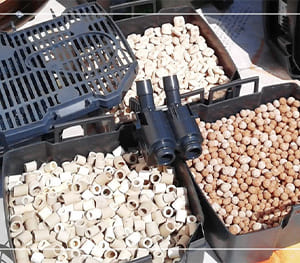
Pump
Additionally, bacteria can colonize various surfaces associated with the pump and its components by utilizing the water’s movement for their benefit

Rock formations and decorative ornaments
The surfaces of rocks and decorations within the aquarium provide additional area for favorable bacteria to establish themselves.
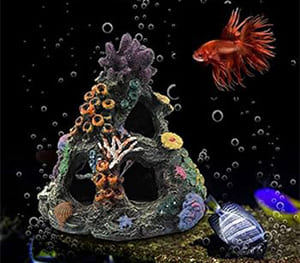
Aquarium walls
Even the inner walls of the tank can serve as a habitat for these beneficial microorganisms.
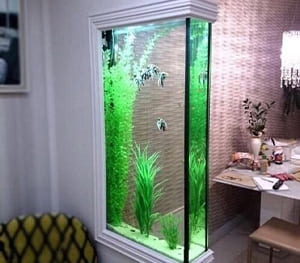
Live or artificial plants
Both real and fake plants can become colonization sites for beneficial bacteria in aquarium, particularly on their leaves and stems.
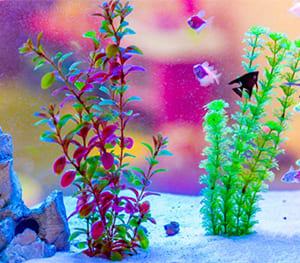
Driftwood pieces
Driftwood also offers a suitable substrate for bacterial growth.
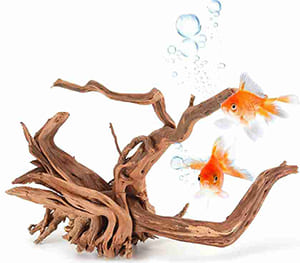
Tubes and heaters
Any tubing or heaters present in the aquarium may harbor beneficial bacteria on their surfaces.
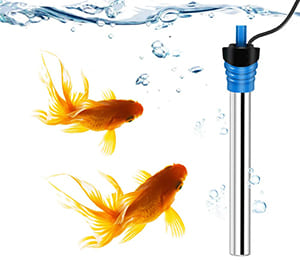
How Long Does it Take to Grow Bacteria in Aquarium?
The duration of growth of beneficial bacteria in aquarium filter relies on the method you select. There are two effective approaches that can be employed:
Quick Method with Established Media: The quickest way to foster the growth of beneficial bacteria for fish tank involves incorporating filter media or substrate from a well-established and healthy aquarium. It takes almost 2 weeks where ammonia and nitrite levels remain low.
Natural Cycling: If time is not an issue, setting up a new tank could take around 4 to 6 weeks for water parameters to reach desired levels naturally.
These two process for growing beneficial bacteria for fish tank has been elaborated below.
How to Grow Beneficial or Good Bacteria for Fish Tank?
It is essential to foster beneficial bacteria in aquarium for the promotion of a thriving aquatic environment.
Here’s a detailed guide on how you can achieve this:
Step 1: Utilize Established Filter Media or Substrate
Acquire filter media or substrate from a well-maintained aquarium as a means to introduce beneficial bacteria into your tank expeditiously.
Step 2: Explore Bottled Bacteria Products
Enhance bacterial proliferation by utilizing commercially available products specifically formulated for both freshwater and saltwater tanks, typically resulting in visible growth within approximately two weeks.
Step 3: Establish a natural cycle for your aquarium
Introduce resilient starter fish such as guppies or mollies to your tank, following the guideline of one small fish per 7 to 10 gallons. – Regularly check ammonia levels using a test kit to prevent rapid increases that could harm the fish.
Step 4: Incorporate Live Plants
You can increase bacterial growth and oxygenation by incorporating live plants into your tank.
Step 5: Introduce Established Filter Media
Utilize filter media from a pre-existing tank to introduce a significant population of bacteria.
Step 6: Well-Established Gravel
Adding gravel from a tank with optimal levels of bacteria can also be an effective method.
Step 7: Maintain Appropriate Water Temperature
Beneficial bacteria for fish tank flourish within the temperature range of 65°F and 85°F (18.3°C to 29.5°C). Moreover, use an adjustable heater equipped with a thermostat for gradual adjustments in temperature.
Bursting Myths Regarding Beneficial Bacteria
Myth #1: Only beneficial bacteria are important
Some people think that the only prominent components of the biofilm in filters are nitrifying bacteria. But this couldn’t be further from the truth.
In addition to nitrifying bacteria, filters also support a wide range of other organisms, such as archaea, worms, ciliates, and flagellates.
The community of microorganisms that makes up biofilms transforms waste into energy and food for its members, enhancing fish health.
Myth #2: Healthy bacteria quickly perish in the absence of food
It’s a common misconception that healthy bacteria need to be fed daily to survive. Actually, they can go for months or even years without eating.
According to studies, ammonia-oxidizing bacteria can start up again even after being starved for a long time.
Myth #3: Growth is halted by high nitrite levels
Some believe that the usage of sodium nitrite as a preserver causes nitrite levels above 9 ppm to inhibit the growth of helpful bacteria.
The presence of sodium nitrite in food, however, preserves colour without impeding bacterial growth.
Myth #4: High Ammonia Levels Are Bad
Another myth is that nitrite-oxidizing bacteria throughout cycling can be harmed by ammonia concentrations greater than 5 ppm.
Numerous studies have shown that beneficial bacteria for fish tank are most active at ammonia concentrations of about 400 ppm.
FAQ’s
What happens if you put too many beneficial bacteria in aquarium?
There is nothing to worry about if you put too many beneficial bacteria in aquarium because the more the quantity the better it is! However, if they increase a bit too much, the maximum that could happen is bacterial bloom, which usually clears on its own.
Does aquarium beneficial bacteria need oxygen?
Yes, beneficial bacteria need oxygen because they need to break down waste.
Does beneficial bacteria eat ammonia?
Since beneficial bacteria are obligate chemotrophs they eat chemicals ammonia and nitrite only.
What is the pH level of beneficial bacteria?
7 to 8.5 pH is the ideal pH for beneficial bacteria.
What temperature kills beneficial bacteria in aquarium?
If your temperature exceeds 90°F, beneficial bacteria start to die.



